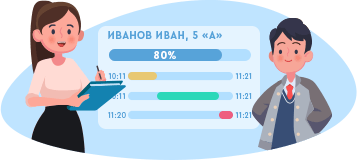— Hello, friends! My name is Martin Green. My friend’s name is James Wilson.
— Welcome to our lesson!
Yesterday James and I visited a website. People on this website can express their opinions on different topics. They were talking about Past Perfect and Past Perfect Continuous Tenses all the evening yesterday. Let’s look at their conversation.
— Guys, look what I found in my daughter’s schoolbook about Past Perfect and Past Perfect Continuous Tenses. “To form Past Perfect, we use the auxiliary verb had plus the third form of the verb”.
— Really? How awful! I had a bad mark in English at school, but I’m sure that we use the second form of the verb.
— Yeah, I think so too. But there is more… “To form Past Perfect Continuous, we use the auxiliary verb had been plus the verb with the -ing suffix”.
— Oh my God! How dare they make such awful mistakes in schoolbooks?
— Yeah, it’s unbelievable!
— Oh, come on, guys. There are no mistakes in this book.
— How can you say that? There are two serious mistakes.
— No, there aren’t.
— Yes, there are!
We watched them arguing. They couldn’t reach collective agreement. That’s why we decided to help them. Martin and I told them that we know everything about these two tenses. We suggested to contact each other on Skype, where we can tell them everything we know. They agreed.
Today in the lesson we will:
· Revise the use of Past Perfect and Past Perfect Continuous Tenses;
and
· Revise the formation of these tenses.
— Meet our guests, please. This is Meggie, Steve, Max and Tom.
— Hello, boys, you intrigued us.
— Yeah, tell us everything you know about these two tenses!
— Hello! First of all, we’ll tell you when we can use Past Perfect.
One. We use Past Perfect to describe the action that started in the past and continued till the certain moment in the past. In these sentences we often use: for and since.
For instance: Marry spent amazing day with her boyfriend. She had planned it since Tuesday.
Two. We use Past Perfect to talk about our personal life experience in the past.
For instance: The last day of my vacation was the best day I had ever had.
Three. This tense can be used with Past Simple. Past Perfect in these sentences describes the action that was completed earlier than the other action in the past. To describe the other action, we use Past Simple. In such sentences we can see the following words: by, after, before, earlier and first.
For instance: My mom came to school at 4 p.m., but the headmistress had left earlier.
Four. Past Perfect is often used to explain the reason. In these sentences we want to show that the action in Past Perfect caused another action.
For instance: My dog was thirsty. It hadn’t drunk anything since morning.
Five. This tense is also used to form conditional sentences type III after the conjunction if. The third type is used to show a regret in the past.
For instance: If you had bought a birthday present for your son, he wouldn’t have been so disappointed.
Six. We use Past Perfect in the following constructions: hardly … when, no sooner … than. These constructions show that the action was completed right after the other. In these sentences we use the reverse order of the words.
For instance: No sooner had Amy drunk her coffee than Ivy called her on the phone.
— Now you know when we can use Past Perfect.
— Can you tell us when we can use Past Perfect Continuous?
— Sure, no problem.
One. We use Past Perfect Continuous if the action started in the past and continued till the certain moment in the past. This function shows the duration of the action.
In such sentences we can use the following words: for, since, by the time, before and after.
For instance: Zoe had been baking a cake for two hours before the guests came.
Two. This tense is used to show that the action continued during some period of time in the past. The result of the action was also seen in the past. In such sentences we often specify the duration of the action.
For instance: My dad had been talking to his client for three hours when we entered his office.
Three. We don’t use this tense with the state verbs such as: to hear, to love, to hate, to wish, to adore, etc. If we use these verbs, we need to replace Past Perfect Continuous with Past Perfect.
For instance: My granny’s dog had adored her for all its life.
— Thanks, guys! Now we know when we can use these two tenses, but we still don’t know how to form them.
— Our views differed on this matter!
— Help us to solve the problem, please!
— Of course, we’ll help you! Let’s start with Past Perfect.
To form positive sentences, we put the subject in first place, then we put the auxiliary verb had, which we use with all the pronouns. Then we put the past participle of the main verb. If the verb is regular, we add the ending -ed, for example: had watched, had played, had jumped. If the verb is irregular, we use the third form of the verb, for example: had begun, had chosen, had given.

To form negative sentences, we put the subject in first place, then we use the auxiliary verb had plus not, the short form is hadn’t. After that we put the past participle of the main verb. For example, if the verbs are regular, we’ll have: hadn’t watched, hadn’t played, hadn’t jumped. If the verbs are irregular: hadn’t begun, hadn’t chosen, hadn’t given.

To form questions, we put the auxiliary verb had in first place, then we put the subject and after that, we use the past participle of the main verb.

For example:
If the verbs are regular, we’ll have:
Had I watched, had they played, had we jumped?
And if the verbs are irregular, we’ll have:
Had you begun, had she chosen, had he given?
Now let’s discuss how to form sentences in Past Perfect Continuous Tense.
To form positive sentences, we put the subject in first place, then we put the auxiliary verb had been, which we use with all the pronouns. Then we put the main verb with the –ing suffix.
For example: I had been drinking tea. We had been laughing. She had been feeding her cat. He had been washing up.

To form negative sentences, we put the subject in first place, then we put the auxiliary verb had been plus not. The short form is hadn’t been. Then we put the main verb with the –ing suffix.
For example: I hadn’t been drinking tea. We hadn’t been laughing. She hadn’t been feeding her cat. He hadn’t been washing up.

To form questions, we put the auxiliary verb had in first place, then we put the subject. After that, we put been and then we use the main verb with the –ing suffix.

For example: Had I been drinking tea? Had we been laughing? Had she been feeding her cat? Had he been washing up?
— Oh, guys, you helped us a lot! Now we know the truth!
— See? I told you. There are no mistakes in the book.
— Yeah, we must admit that we were wrong on this matter.
— Now you know when we can use these two tenses and how to form them.
— Do you want to know what time markers we can use with them?
— Yes, of course! It’s very interesting.
In Past Perfect Tense, we use the following markers: when, by the time, by (for example: by Friday, by next week, by march, by 9 a.m.), before, after, as soon as, once.
In Past Perfect Continuous Tense, we use: by the time, before, after, still, all day, until, for some time before, How long?
— That’s all, our friends!
— Guys, we understood all the information!
— We really appreciate that you could find the time for this conversation.
— Thank you so much!
— You’re welcome. It was a great pleasure for us to meet you!
— We hope you liked the lesson.
— See you soon, boys and girls!

 Получите свидетельство
Получите свидетельство Вход
Вход





 651
651

